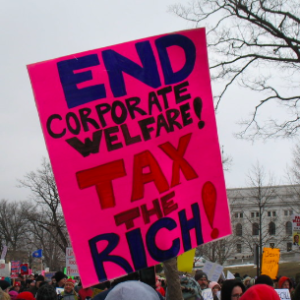Exhibiting no self-awareness, Bernie Sanders and Elizabeth Warren (worth $2.5 million and $12 million, respectively) yell the loudest about the rich having to “pay their fair share.” President Joe Biden has, predictably, joined this tin-eared chorus. Yet none of them will ever say what that fair share is.
Each year, the Congressional Budget Office (CBO) asks Americans how much they earn and how much they pay in federal taxes. Breaking down those answers by income level provides some valuable insight into who is paying what. To sidestep problems like write-offs and deductions, wages versus interest, and payroll versus capital gains, the CBO lumps together all the federal taxes people actually pay. In another pile, it places all the market income people actually earn. Dividing the first number by the second yields the fraction of people’s incomes that they actually pay to the IRS. Any discussion of what’s “fair” must start here.
In 2017 (the last year for which data is available), average household income among the top 1 percent, the middle 20 percent, and the bottom 20 percent was $2 million, $61,700, and $15,900. After performing all the various accounting gymnastics to reduce tax burdens, those three groups paid 32, 17, and less than 2 percent of their incomes in federal taxes respectively. In other words, the average one-percenter household earned about 125 times what the average bottom 20-percenter household earned, but paid over 2,000 times the federal taxes.
But this isn’t the entire story, because while the federal government takes with one hand, it gives with the other. The government hands out means-tested transfers like Medicaid, CHIP, SNAP, Temporary Assistance for Needy Families, housing assistance, income assistance, energy assistance, and child nutrition programs, plus earnings-tested transfers like Social Security benefits, unemployment insurance, and workers’ compensation.
Workers tend to think of social insurance benefits – particularly Social Security retirement benefits – not as government transfers but as a return on the money they paid into the social insurance system. In fact, the Supreme Court held in 1960 that Social Security benefits are not a contractual right (Fleming v. Nestor), regardless of what potential recipients might think. In the end, Social Security is the same as any other federal tax and transfer program.
Transfers are largely things the government does to help lower-income households. But regardless of the intention, transfers are negative taxes. Subtracting transfers from taxes yields net federal taxes paid. And here the numbers take a surprising turn. The average household among the top 1 percent paid $620,000 in federal taxes and received $1,300 in transfers, for an effective net tax rate of 31 percent. The average middle-income household paid $10,500 in taxes and received $16,800 in transfers for an effective net tax rate of negative 10 percent. The average household among the bottom 20 percent paid $300 and received $20,300 in transfers for an effective net tax rate of negative 126 percent.
Our tax and transfer system has become so progressive that, on average, only the top 40 percent of households pay more in taxes than they receive in transfers. Almost by definition, every tax cut is a tax cut for the rich because those are the only households that are net payers. In a democracy, a system like this can become dangerously unstable. When net recipients constitute more than half of all voters, the majority will vote for ever more spending for themselves. Trillion-dollar deficits then become the norm.
We get here not because of economics or politics, but because of human nature. People always want more in exchange for less. Politicians have merely discovered how to turn people’s desires into votes. The trick lies in telling the majority that the rich aren’t paying their fair share while being careful not to define “fair.” Calls for the rich to pay “their fair share” will never end because proponents actually don’t mean “fair” at all. They really only mean “more.”

